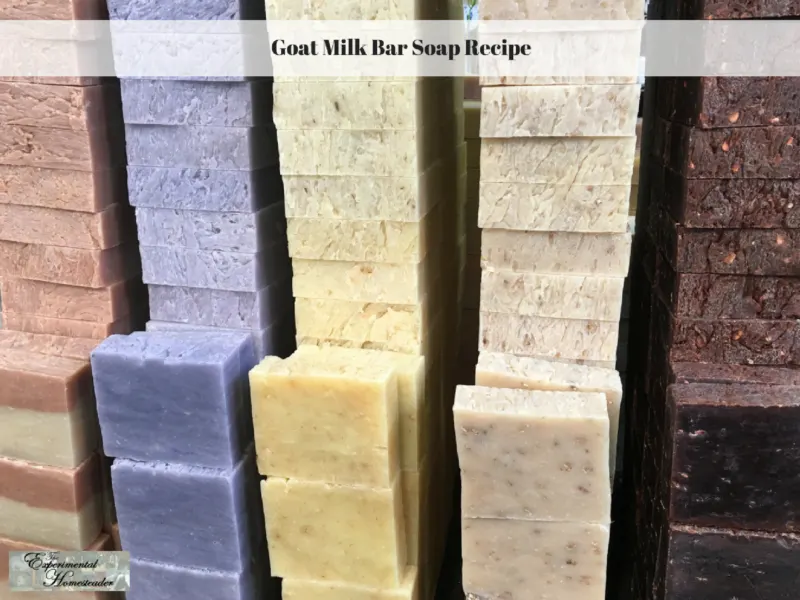Many store bought soaps I have tried caused skin rashes or other issues with my sensitive skin, so I decided to make my own goat milk bar soap recipe.
Soap is a necessity without a doubt, but store bought soap is often full of chemicals or heavy perfumes that trigger allergies.
Organic soap is often hard to find or expensive.
These are just a few reasons why finding a good goats milk soap recipe that is easy to make is so important to so many people - including myself - these days.
Supplies Needed For Making Goat Milk Soap
Homemade goat milk soap is not hard to make, but I recommend making sure you have a quiet place to work away from distractions.
Lye can be dangerous so it is best to keep kids and pets away from it.
Caution should be used when you are mixing the ingredients, but there is nothing to be afraid of as long as you use common sense and follow the instructions exactly.
There are a few basic supplies you need before you begin to make this goat milk soap recipe.
There are many goats milk soap recipes out there including ones that use powdered goats milk, but personally I prefer this one because I raise dairy goats and have the excess milk available.
Goat milk soap is also the most famous type of bath soap because of its soothing effect to the skin.
When you make your own homemade goat milk soap, you can use other liquids for your lye solution, if you prefer.
The most popular alternative to water is goat's milk but it is not the only option.
Goat's milk makes a rich and creamy soap that moisturizes the skin which is why I love it so much.
Other soap makers use coconut milk when they milk soap because it produces a richer lather.
Some soap makers use cow's milk or even buttermilk.
All of these alternatives are good for keeping the skin moisturized and it really just comes down to personal preference as well as what liquid is easily accessible.
Benefits Of Using A Goats Milk Soap Base Recipe
It may seem strange making soap using goat milk but goat milk soap is gentle therefore, great for those with sensitive skin, adults and babies alike.
The benefits of goat milk soap come from the fact that it does not contain harsh or artificial ingredients like detergent, hardener and perfume that can dry and irritate the skin.
Goat milk soap is also an excellent moisturizer because it has natural lipids, which lock in moisture and help keep the ideal pH level of your skin.
Goat milk soap is the perfect soap to treat skin problems like acne or eczema.
One drawback of making goat milk soap is that it is more difficult than making regular soap because goats milk has a different reaction to the rest of the ingredients such as the vegetable oils and sodium hydroxide commonly called lye or caustic soda.
Additional Tips For Making Homemade Goat Milk Soap
There are many methods for making homemade soap. Here are a few additional ideas for you to try and soap making tips.
You should be extra careful when making your own milk soap because different liquids can aggressively react with lye.
In addition, a foul odor is sometimes produced as lye burns up the milk sugars.
However, the foul odor does not stay in the final milk soap product.
You can follow the steps below to lessen the burning of milk sugars and chemical reaction:
- Always wear protective gears like goggles, apron, long sleeve shirt and gloves.
- Place a large bowl in your sink that is filled with ice or frozen milk. I personally do not freeze my water or milk when making soap, but many people do.
- Put your purchased lye in the bowl and slowly pour in ⅓ of your milk that is in liquid form and then the other ⅔ in frozen, icy form.
- Using a wooden spoon with a very long handle, continuously stir the milk soap base but be cautious with the reaction that will occur.
- During the chemical reaction of the lye and milk, the soap base may produce a lot of bubbles causing the mixture to tip over the bowl.
- Wait for the reaction to stop.
- After the reaction is done, again continuously stir the milk soap base until the milk and lye reaches trace.
- Wait for it to cool down then you can add the essential oils and fragrances.
- Pour the soap base in the molds and then let it set under room temperature.
- Let it cure for three to five days and then you can remove them from the molds. I normally remove the soap within 24 to 48 hours, but sometimes it is not dry enough to remove - or I simply get busy - so I let it cure in the mold longer.
- For best results let the soap dry out completely for another week. The soap's color darkens after it is completely dried.
The above procedure is the same if you intend to use plain water instead of milk.
Final Thoughts About Making The Best Goat Milk Soap
The best goat milk soap available is the kind you make using goat milk from your own goats and simple ingredients that you can pronounce as far as I am concerned.
Here are a few more tips for making goat milk soap as well as some of the advantages of this type of soap.
When it comes to making goat milk soap recipes, beginners and experienced soap makers alike, should do it when there are no children or pets around to avoid risks of accidents.
If you have sensitive skin or dry skin, try making some of this soap at home for a great natural skin remedy.
Goat milk soap is available commercially but it is a bit more expensive than regular soap.
Now that you know how to make goat milk soap at home, you can stock up on it, customize it to contain the ingredients and scents you prefer.
Making your own goat milk soap is a great way to also avoid potential allergens that might be in commercial bars of soap.
Goat milk soap is also a value added product that many small farmers and homesteaders sell to help make ends meet.
Bars of homemade goat milk soap make great DIY gifts for family and friends.
Goats Milk Soap Base Recipe For Beginners
Here is my go-to goats milk soap base recipe.
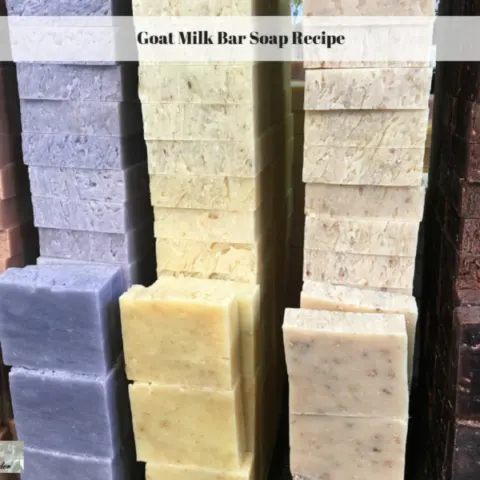
Easy Homemade Goat Milk Soap
For those who have access to fresh goat milk, this homemade goat milk soap recipe is a good one for beginning soap makers to start with because it is easy to make. Plus this homemade goat milk bar soap recipe is gentle on the skin because it does not contain harsh or artificial ingredients.
Materials
- 5 ½ pounds of lard
- 3 pints of ice cold goat milk
- 12 ounces of lye
- 2 ounces glycerin
- 2 Tablespoons Borax
- ⅓ cup honey
- Essential Oils of choice
Tools
Instructions
- Before beginning slightly freeze your goat milk. You want small chunks of ice in it, but you do not want it completely frozen.
- Pour the lye, in powder form, into the milk.
- Be careful here as the lye will quickly heat the milk up. Stir as you do this. You do not want the milk to get too hot and curdle.
- Once the milk and lye are well mixed, add the honey.
- The ideal temperature for the lye mixture will be around 85 degrees F, but be warned the mixture will need to cool down some to reach this temperature.
- Once the milk, honey and lye have been mixed together, set the pan aside, with a lid on it, if possible, so the mixture does not cool too fast. Stir occasionally.
- Put the lard into another container and heat it up until it reaches 90 degrees F then remove it from the heat.
- When the contents are both pans are the right temperatures, 85 degrees F for the lye mixture and 90 degrees F for the lard mixture, slowly pour the lard into the lye mixture. Stir constantly and be careful not to splash this mixture. You do not want to get any of this on your skin.
- When the lye mixture and the lard are well mixed, add the glycerin and borax. Stir constantly until the mixture thickens. When the mixture becomes the consistency of pudding, drizzle some of the soap on top of the mass of soap. If you can see the drizzle briefly before it sinks back into the mass of soap, the soap has begun to “trace” and is ready to pour into a pan to cool. This process can take anywhere from a few minutes to an hour.
- Pour the soap into a pan and allow to cool overnight. You can add essential oils, herbs or other ingredients at this point or simply allow the plain soap to cure. This is the last step to make homemade soap unless you want to make hand milled soap.
- If you allow the soap to cure without additives, when it is dry, which can take 6 weeks or longer, you can grate the soap, add nine ounces of waterto twelve ounces of soap flakes, re-melt and add the additives. This is then known as hand milled soap.
Recommended Products
Sheri Ann Richerson is a participant in the Amazon Services LLC Associates Program, an affiliate advertising program designed to provide a means for sites to earn advertising fees by advertising and linking to Amazon.com.
-
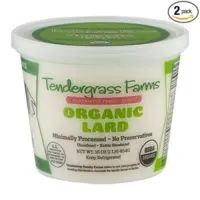 Organic Lard, 16 oz. (2 Pack)
Organic Lard, 16 oz. (2 Pack) -
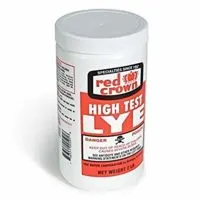 Red Crown High Test Lye for Making Award-Winning Handcrafted Soaps 2 lb. (1, Non-Food Grade)
Red Crown High Test Lye for Making Award-Winning Handcrafted Soaps 2 lb. (1, Non-Food Grade) -
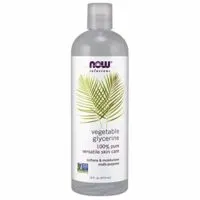 NOW Solutions Vegetable Glycerine (Liquid), 16-Ounce
NOW Solutions Vegetable Glycerine (Liquid), 16-Ounce -
 Borax 20 Mule Team Detergent Booster, 76 Oz.
Borax 20 Mule Team Detergent Booster, 76 Oz. -
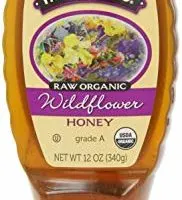 HoneyTree's Raw Organic Honey, Wildflower, 12 Ounce
HoneyTree's Raw Organic Honey, Wildflower, 12 Ounce -
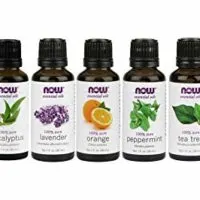 Now Foods Essential Oils 5-Pack Variety Sampler - 1oz each
Now Foods Essential Oils 5-Pack Variety Sampler - 1oz each -
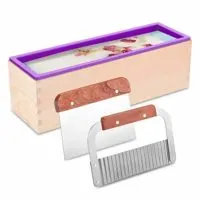 ZYTJ Silicone soap molds kit kit-42 oz Flexible Rectangular Loaf Comes with Wood Box,Stainless Steel Wavy & Straight Scraper for CP and MP Making Supplies
ZYTJ Silicone soap molds kit kit-42 oz Flexible Rectangular Loaf Comes with Wood Box,Stainless Steel Wavy & Straight Scraper for CP and MP Making Supplies -
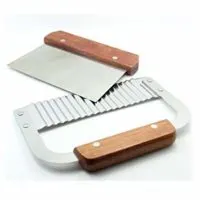 Ehdching 2pcs Stainless Steel Wavy & Straight Soap Mold Loaf Garnish Potato Vegetable Cutter Cutting Tool
Ehdching 2pcs Stainless Steel Wavy & Straight Soap Mold Loaf Garnish Potato Vegetable Cutter Cutting Tool -
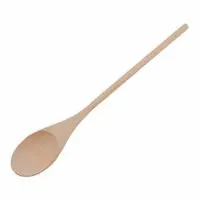 1 X Long Handle Cooking Mixing Wooden Spoon 18in P018
1 X Long Handle Cooking Mixing Wooden Spoon 18in P018 -
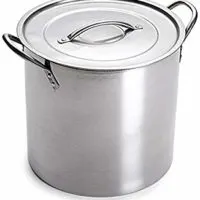 5 Gallon Stainless Steel Stock Pot with Lid, 12.5 x 12.5 x 11.5
5 Gallon Stainless Steel Stock Pot with Lid, 12.5 x 12.5 x 11.5 -
 3M 91252-80024 Chemical Splash/Impact Goggle, 1 -Pack
3M 91252-80024 Chemical Splash/Impact Goggle, 1 -Pack -
 ThxToms Heavy Duty Latex Gloves, Resist Strong Acid, Alkali and Oil, 14", 1 Pair
ThxToms Heavy Duty Latex Gloves, Resist Strong Acid, Alkali and Oil, 14", 1 Pair -
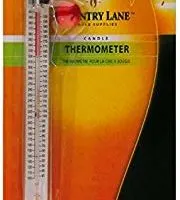 Country Lane Candle Supplies Clip-On Candle Thermometer for Homemade Candle and Soap Crafting
Country Lane Candle Supplies Clip-On Candle Thermometer for Homemade Candle and Soap Crafting
I highly recommend the following articles:
- Basic Goat Milk Soap Recipe
- Goat Milk Laundry Soap Recipe
- Goat Milk Soap Recipes Round-Up
- How To Start Freezing Goat Milk
- Goat Milk Soap Recipe
Use the buttons on the right side to share this article with friends or family who might find it useful. Pin the picture below to your pinboard on Pinterest for future reference.


